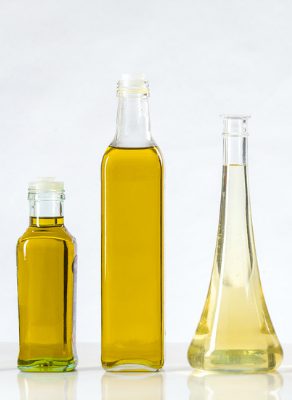- Vitamin E is a fat-soluble vitamin
- It is a family of 8 molecules, including alpha-tocopherol, which is the most active
- It is a powerful antioxidant with cardioprotective effects
- Fats as well as some vegetables are the best sources of it
- It must be stored away from light
- A deficiency of it is fairly rare
Why should we
eat some daily?
Vitamin E, or tocopherol, is a fat-soluble vitamin, meaning it dissolves in fat. In nature, there are 8 different forms of vitamin E compounds (alpha-, beta-, gamma-, and delta-tocopherols, and alpha-, beta-, gamma-, and delta-tocortienols). The most commonly found form is alpha-tocopherol, which is also the most active vitamin component.
Vitamin E is a physiological antioxidant, the intake of which is closely linked to our consumption of polyunsaturated fats. These help make up the cellular membrane and the proteins which carry fats into the bloodstream. They are very sensitive to oxidation, and vitamin E is their protective shield. As these fats must be a part of our daily diet, it is important to have sufficient vitamin E intake to go along with them.
Vitamin E is a veritable natural shield . Find out why and how!
What is
its role?
The main function of vitamin E is that of antioxidant: it protects the cell membranes, proteins, lipids, and DNA in our bodies by trapping free radicals and preventing them from spreading. In this way, it prevents the oxidation of bad cholesterol (LDL) which then is not deposited in the arteries as easily.
As vitamin E also has anti-inflammatory, antiplatelet, and vasodilatory properties, it also plays a cardioprotective role.
Numerous studies show that food that is naturally rich in vitamin E plays a cardioprotective role. This effect is not seen when vitamin E is taken as a supplement, because it is not in the same form as it is in food.
What is the
recommended intake?

Where is
it found?
Since vitamin E is fat-soluble, it is primarily found in fats, and the main sources are plant-based: oils (soy, corn, sunflower), margarine, oilseeds (such as walnuts, hazelnuts, and almonds), seeds (such as sunflower seeds), and cereal germs.
Fruits and vegetables are the second best source of vitamin E. They do not have a very high content, but the size of the portions consumed makes them a non-negligible source: between 12% and 18% of vitamin E intake comes from fruits and vegetables.
Vitamin E
content in food
| Vitamin E content in food | mg/100g |
| Sunflower oil | 56 |
| Margarine | 43 |
| Grapeseed oil | 32 |
| Wheat, hazelnut or almond germ | 20-25 |
| Peanut oil, rapeseed oil, soybean oil | 15-20 |
| Olive oil, walnut oil | 10-15 |
| Peanuts, eel, fish oil | 5-10 |
| Walnuts, butter, egg yolks, dandelions, sweet potatoes | 2-5 |
| Spinach, asparagus, chickpeas, cress, chestnuts, broccoli, tomatoes, smoked salmon, omelet, whole wheat bread | 1-2 |
| Source: Ciqual |
Did you know? The vegetables with the highest vitamin E content are sweet potatoes, dandelions, spinach, asparagus, chickpeas, cress, avocado, broccoli and lamb’s lettuce.
What can you do with lamb’s lettuce? Try this recipe: lamb’s lettuce with apricots, almonds and honey!
Preconceived notions
about vitamin E
Who said fats weren’t good for you? In addition to essential polyunsaturated fats, vegetable oil (non-hydrogenated) provides you with this antioxidant vitamin which protects your cells. No need to add a lot of vegetable oil to your meals to draw the benefits from it: a drizzle of it on top of raw or cooked vegetables is enough to them richer in vitamin E. When paired with the vitamin C and beta-carotene found in vegetables, the result is a nice antioxidant cocktail!
What are
its particularities?

Vitamin E is fairly resistant to heat, but not to light or oxygen. It is therefore preferable to store foods with high vitamin E content away from light (for example, in a cupboard) and in airtight containers.
Another source of loss of vitamins is food waste! Read all the latest news on this subject
What if I eat
too much or too little?
It is rare for adults to suffer from serious vitamin E deficiency. In the long term, the signs are neurological problems due to inadequate nerve conduction. In most cases, this is linked to a problem with intestinal absorption of vitamin E, which is a symptom of certain diseases (Crohn’s disease, celiac disease). In newborn babies, vitamin E deficiency can lead to retinal damage which can be detected at an early age via an examination of the back of the eye. In children, sensory neuropathy, areflexia (absence or abolition of one or more reflexes, such as walking), or retinal problems may occur in the case of chronic deficiency.
Unlike vitamin D or A, vitamin E is not very toxic. The European Food Safety Authority (EFSA) assesses that the risks linked to excessive consumption are low.



 Garlic
Garlic  Rye
Rye  Vegetable garden: growing sorrel
Vegetable garden: growing sorrel 













